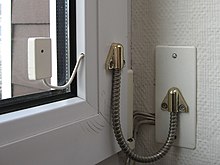Glass break detector
Glass break detectors are used to detect the breakage of a window pane in order to protect against break-ins. They are used to monitor the outer shell of intrusion alarm systems .
A distinction is made between different variants of glass break detectors.
Passive sensors
Acoustic glass break detectors
Acoustic glass break detectors react to airborne sound and are installed in the area of the glass surface to be monitored. They have a built-in microphone and react to characteristic frequencies that arise when a glass breaks. As a rule, these are low frequencies (impact) and then high frequencies (glass splinters) as well as infrasound waves (changes in air pressure) that occur when the pane breaks through. The typical minimum target size for triggering is around 30 cm × 30 cm. This safely prevents it from being triggered by breaking drinking glasses. The maximum distance between the glass break detector and the pane is seven to ten meters. All panes within this radius are monitored. Acoustic glass break detectors require a supply voltage that is supplied by a conventional battery or via the wiring.
Passive glass break detectors
Passive glass break detectors also work acoustically, but are glued directly to the glass surface to be monitored and register structure-borne noise. A piezoelectric sensor reacts to typical glass break vibrations in the range of 100 kHz, which occur when the pane is destroyed. Triggering by knocking on the glass pane is not possible. The monitoring radius on the disc is between 1.5 and 3 meters. Noises made by glass cutters are usually not recognized. Passive glass break detectors are available in three versions:
- Line feed: The connections are connected in series to trigger an alarm . The power supply is provided by the alarm system (up to VdS class B).
- Separate supply voltage: The detectors have potential-free relay contacts that can be switched in series, but require their own power supply. Such detectors can be connected to any intrusion alarm system (up to VdS class B).
- No supply voltage: the sensor triggers automatically by means of a piezo effect .
Active glass break detectors
Active glass break detectors consist of an ultrasonic transmitter and one or more receivers. The transmitter and receiver are mounted on the windshield and are now often housed in the same housing. If the pane is dented or damaged, the transmission medium ( glass ) between the transmitter and receiver changes. Active glass break detectors require their own supply voltage and correspond to the highest security class (up to VdS class C).
Glass break detector with alarm wires
With the alarm glass, a network of electrical conductors, an "alarm spider", is attached to the glass or embedded in the glass in one corner of the glass. If the glass breaks, the conductors of the alarm spider are interrupted and an alarm is triggered.
In the past, glass break detectors with alarm wires or alarm foils (standard designation: area protection , abbreviation : FÜ ) were also used as alarm detectors to protect areas against breakthroughs. The alarm wire was attached between the panes of the glass surface to be secured. If the current-carrying wire broke, the alarm was triggered by interrupting the electrical circuit.
Individual evidence
- ↑ http://www.alarm-laden.de/shop/datenblaetter/FU7300W.pdf
- ↑ Thomas Laasch, Erhard Laasch: Haustechnik: Basics - Planning - Execution, Edition 11, 2005, ISBN 3519252651 , page 402 ff., Online
- ↑ Wolfger Pöhlmann: Handbook on exhibition practice from A to Z, Gebrüder Mann, Berlin, 2007, p. 144, online
- ^ Deutsche Bauzeitung: Fachzeitschrift für Architektur und Bautechnik, Volume 116, 1982, P. 74 Online
